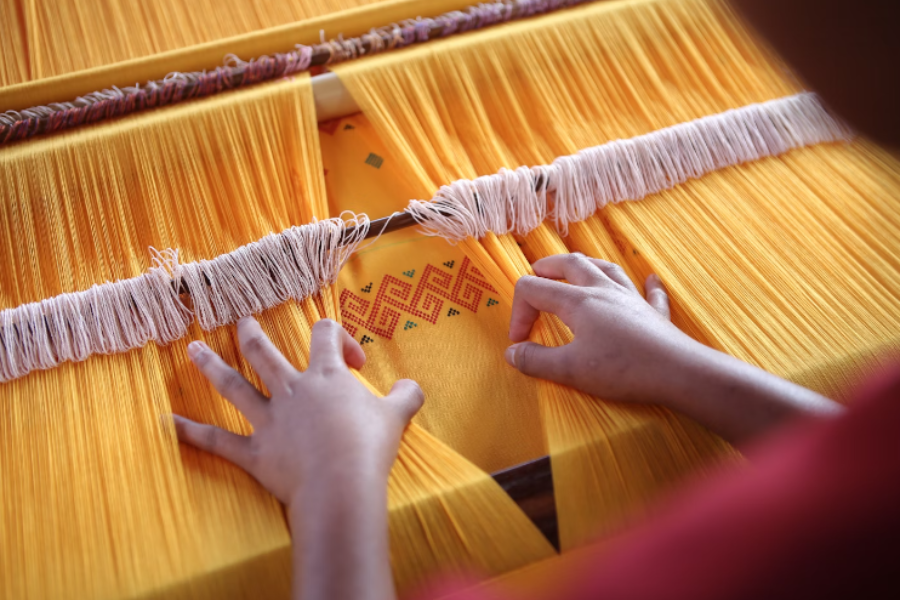“The Modern Weave: How Tissariss is Adapting to Contemporary Art”
Tissariss is far more than a mere weaving technique; it represents a rich cultural legacy, an artistic expression that has resonated across generations. Rooted in history, this craft marries ancient traditions with modern creativity, resulting in vibrant textiles that tell unique stories. Each intricately woven piece carries deep cultural significance, reflecting the heritage of the communities that have kept this tradition alive.
What is Tissariss?
Tissariss is a centuries-old weaving art known for its detailed patterns and brilliant colors, often embodying cultural stories. This practice turns simple threads into breathtaking works of art, with every piece serving as a reflection of the weaver’s heritage.
Originating from regions rich in history, Tissariss has been passed down through generations, blending functionality with artistic expression. Over time, this weaving tradition has not only preserved cultural narratives but has also adapted to modern aesthetics, bridging the gap between the old and the new.
Historical Roots and Evolution of Tissariss
Tissariss has ancient roots, deeply intertwined with the cultural and social fabric of various communities. Traditionally, this art form served as a way to communicate stories and preserve important events and beliefs, with each piece representing more than just material goods—it encapsulates history and tradition.
As time passed, Tissariss evolved, with artisans refining their techniques while preserving its core essence. Today, this intricate weaving remains a testament to the enduring connection between craftsmanship and culture, with each piece narrating a story passed down through generations.
Tissariss Weaving Techniques
The art of Tissariss weaving encompasses a variety of skilled techniques, including hand-looming, knotting, braiding, and twilling. Each method brings unique textures and dimensions to the final product, highlighting the artisan’s expertise and dedication.
The meticulous craftsmanship required for Tissariss weaving is often passed down within families or local communities, preserving the traditional techniques that make each creation a masterpiece. The result is a textile that blends both aesthetic beauty and cultural depth.
Materials and Dyeing Techniques
Tissariss weavers traditionally use natural materials such as cotton, silk, and wool to create their textiles. These fibers not only contribute to the durability of the fabrics but also enhance their visual richness. The craftsmanship involved ensures that every piece is both beautiful and long-lasting.
Natural plant-based dyes derived from roots, leaves, and fruits are used to achieve Tissariss’s signature vivid colors. This environmentally friendly practice not only sustains the craft’s cultural essence but also demonstrates a commitment to ecological preservation.
The Cultural Significance of Tissariss
Tissariss weaving is more than an art form—it is a key expression of cultural identity. Through its intricate designs, weavers tell stories that have been passed down through generations, keeping their heritage alive.
These woven textiles often reflect folklore, spiritual beliefs, and community traditions, making them deeply meaningful. Tissariss connects generations by allowing modern artists to incorporate ancient techniques into contemporary creations, ensuring that the culture remains vibrant and relevant in today’s world.
Symbolism in Tissariss Patterns
The designs found in Tissariss weaving are often laden with symbolism, with each motif representing themes such as nature, spirituality, or community. These designs invite the viewer to explore the cultural stories embedded within the fabric.
Colors also carry significant meanings—bright reds may symbolize celebration and happiness, while earth tones can reflect a connection to nature. This use of symbolism enriches the artistic narrative, allowing each piece to resonate on a deeper level with its audience.
Renowned Tissariss Artists
The world of Tissariss boasts many talented artists who have mastered the craft. Artists like Anaya Ghosh and Ramesh Kumar are celebrated for their exceptional weaving skills, each using their work to reflect both personal and cultural stories.
Their creations are exhibited internationally, inspiring new generations of weavers to explore this ancient craft. Each piece they produce is more than just a textile; it is a work of art that resonates with cultural depth and artistic precision.
Modern Innovations in Tissariss Weaving
While Tissariss is steeped in tradition, modern artists are introducing new innovations to the craft. Digital design tools are being integrated, allowing for the creation of more intricate patterns that push the boundaries of traditional weaving.
Collaborations between Tissariss artisans and contemporary designers are also becoming more common, blending traditional craftsmanship with modern fashion and decor. This fusion of old and new continues to breathe life into this ancient craft, ensuring its relevance in the modern world.
Sustainable Crafting in Tissariss Weaving
Sustainability is a core value in Tissariss craftsmanship. Artisans prioritize using local, natural materials and dyes, which reduces the environmental impact and supports local communities.
The commitment to eco-friendly practices ensures that this art form can thrive for generations to come. By honoring both the cultural and ecological aspects of the craft, Tissariss weaving remains a sustainable and responsible art form.
Artistic Collaborations
Partnerships between Tissariss weavers and contemporary designers have led to exciting innovations, bringing the ancient craft into new contexts. These collaborations create fresh perspectives, blending traditional techniques with modern aesthetics in both fashion and interior design.
Through these creative partnerships, the cultural and artistic value of Tissariss continues to evolve, expanding its reach and significance in the global marketplace.
Tips for Collecting and Preserving Tissariss Art
When acquiring Tissariss textiles, it’s important to seek out authentic pieces from respected artisans or galleries. Researching the background of each artist can deepen your appreciation for the work.
To preserve these delicate creations, avoid exposure to direct sunlight, store them in acid-free materials, and ensure they are kept in a dry environment. Regular care will help maintain their beauty and longevity for years to come.
The Future of Tissariss Weaving
As sustainability becomes increasingly important in the world of art and fashion, Tissariss weaving is well-positioned for a renaissance. Emerging technologies, combined with traditional techniques, are creating new possibilities for artisans.
Collaborations with designers and the use of digital tools are transforming the craft, making it appealing to a broader audience. As this blend of tradition and innovation continues, the timeless beauty of Tissariss will remain cherished for generations to come.
Summary:
Tissariss is a traditional weaving technique that embodies a rich tapestry of history, culture, and artistry. Originating from various regions known for their heritage, Tissariss transforms simple threads into stunning textiles, each piece reflecting the stories and traditions of its creators.
Historically, Tissariss has served as a medium for storytelling, using intricate designs and vibrant colors derived from natural materials and plant-based dyes. The art form is not only a representation of cultural identity but also a means of preserving folklore and rituals.
The craftsmanship involves various techniques, including hand-looming, knotting, and braiding, resulting in unique fabrics with deep cultural significance. Contemporary artists are embracing modern innovations, incorporating digital tools and collaborating with designers, thereby breathing new life into the craft while maintaining its traditional roots.
Sustainability plays a crucial role in Tissariss, with artisans prioritizing local materials and eco-friendly practices. As the craft continues to evolve, it remains a vital expression of cultural heritage, resonating with new generations while celebrating the artistry of the past.
FAQs:
1. What is Tissariss?
Tissariss is a traditional weaving technique known for its intricate patterns and vibrant colors, often rooted in cultural narratives. Each piece reflects the stories and traditions of its creators.
2. What are the historical origins of Tissariss?
Tissariss art has ancient roots tied to the cultural fabric of various communities. It has evolved over time as artisans adapted techniques while preserving their rich heritage.
3. What techniques are used in Tissariss weaving?
Tissariss weaving employs methods such as hand-looming, knotting, braiding, and twilling. These techniques showcase the weaver’s skills and attention to detail, resulting in unique fabrics.
4. What materials are used in Tissariss creations?
Artisans typically use natural fibers like cotton, silk, and wool, along with plant-based dyes derived from roots, leaves, and fruits, to create vibrant and durable textiles.
5. Why is Tissariss culturally significant?
Tissariss serves as a vital expression of cultural identity, reflecting the unique heritage and traditions of communities. It preserves folklore and rituals through intricate designs and storytelling.
6. Who are some prominent Tissariss artists?
Notable artists like Anaya Ghosh and Ramesh Kumar have gained recognition for their intricate patterns and vibrant color palettes, each piece telling stories from their cultural heritage.
7. How is Tissariss evolving today?
Contemporary Tissariss artists are incorporating modern techniques, such as digital design tools, and collaborating with fashion designers, pushing boundaries while respecting tradition.
8. What sustainable practices are involved in Tissariss craftsmanship?
Tissariss artisans prioritize using local materials and natural dyes, promoting eco-friendly practices that minimize ecological impact and support their communities.
9. How can I collect and preserve Tissariss art?
When collecting Tissariss textiles, ensure authenticity by purchasing from reputable sources. To preserve pieces, store them away from direct sunlight, use acid-free materials, and monitor for wear.
10. What does the future hold for Tissariss weaving?
The future of Tissariss weaving looks promising as it blends traditional methods with modern aesthetics and sustainability, appealing to new generations who value craftsmanship and cultural heritage.
Stay in touch to get more news & updates on Newshunter!






